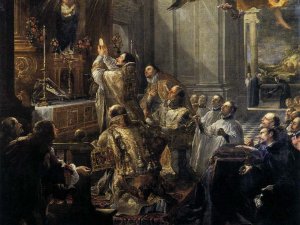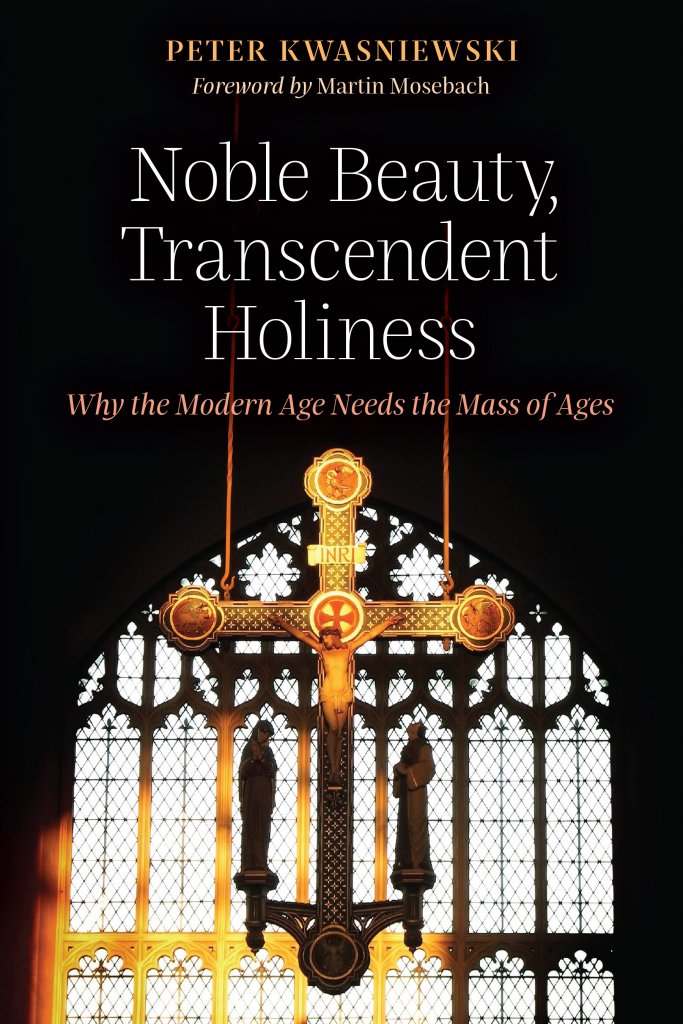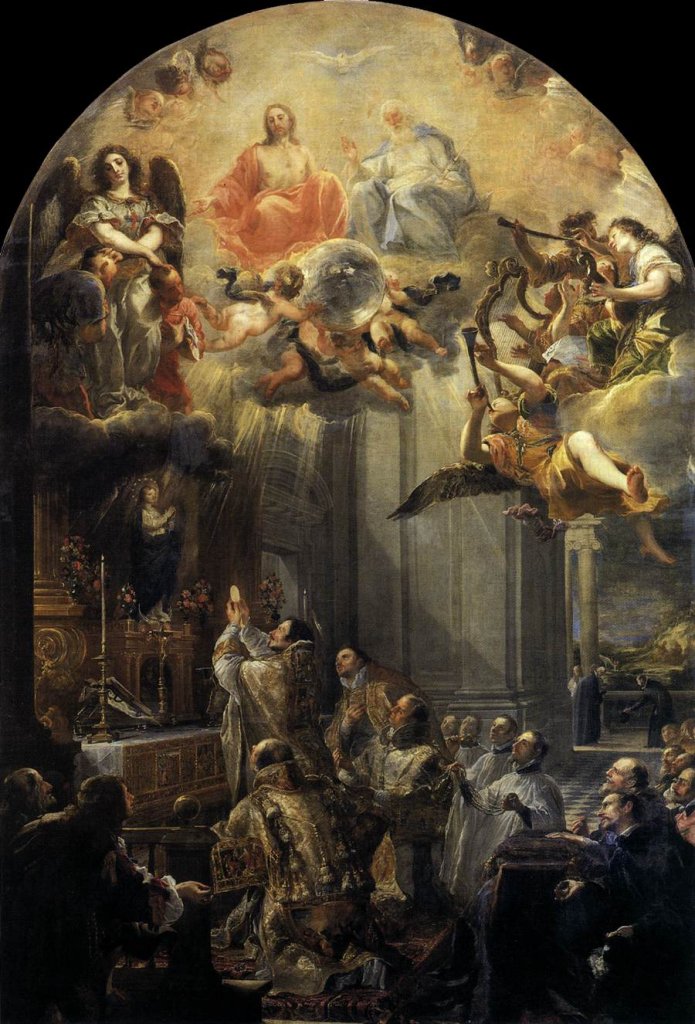“Acceptable Worship, with Fear and Reverence”— An Appreciation of Peter Kwasniewski’s New Book

Editor’s Note: Bishop Athanasius Schneider, who received an advance copy of Noble Beauty, Transcendent Holiness: Why the Modern Age Needs the Mass of Ages — Dr. Peter Kwasniewski’s new book on sacred liturgy — has written the following reflection on it and given us permission to publish it. We are honored to be able to share these thoughts from His Excellency on the topic of the Most Holy Sacrifice of the Mass.
The whole meaning and aim of creation—and in the first place, of the spiritual creatures, namely, angels and men—consists in glorifying the Triune God through their existence, through their life, and through visible acts of worship. The most sublime act of God’s glorification is the worship of adoration (latria), which man has to perform according to his nature, that is, both in a spiritual, interior way and in a bodily, exterior way, as explained lucidly by Saint Thomas Aquinas:
Certain sensible works are performed by man, not to stimulate God by such things, but to awaken man himself to divine matters by these actions, such as prostrations, genuflections, vocal prayers, and hymns. These things are done not because God needs them, for He knows all things, and His will is immutable, and the disposition of His mind does not admit of movement from a body for His own sake; rather, we do these things for our sakes, so that our attention may be directed to God by these sensible deeds and that our love may be aroused. At the same time, then, we confess by these actions that God is the author of soul and body, to Whom we offer both spiritual and bodily acts of homage.[1]
Juan Carreño de Miranda; Mass of St John of Matha (1666)
In order that man may be able to offer God a most worthy worship, God Himself became man and taught us by His words and acts how to worship. Our Lord Jesus Christ demonstrated by His example that the essence of true worship consists in filial fear and in the loving reverence of God: “In the days of his flesh, Jesus offered up prayers and supplications, with loud cries and tears, to him who was able to save him from death, and he was heard because of his reverence” (Heb 5:7). Through His redeeming sacrifice of the Cross, Christ the God-man made men capable of worshiping God truly by associating the Church with this, His own highest act of worship.
The liturgy of the Church is the more true and God-pleasing, the more all of its elements—words, gestures, music, architecture, liturgical objects and paraments, and, of course, the state of mind and soul of the celebrant and of the assisting faithful—correspond to the spirit of Christ the High Priest, to His filial fear and to His loving reverence towards God. He alone is the “universal priest of God the Father,” the “catholicus sacerdos Patris,” according to an affirmation of Tertullian (Adv. Marc., IV, 9; IV, 35). The entire life of Jesus Christ was a glorification, an adoration, of God the Father: “I glorified you on earth” (Jn 17:4). Therefore, the life and work of Christ constitutes a reminder to fallen humanity of the first duty and of the very first commandment: “You shall worship the Lord your God, and Him only shall you serve” (Mt 4:10). Giving glory to God brings true salvation to men, as the liturgy of the Church says: “Our praises add nothing to your greatness but profit us for salvation.”[2]
The Church, the Bride of Christ, has as her first duty to proclaim and to praise the majesty of God and the wonders of His redeeming work. Christ, the only true worshipper of the Father, imbued His Bride with His reverential worshiping spirit. The reverential, adoring, sacred, and keenly Christocentric spirit of the liturgy is part of the spiritual “genetic inheritance” of the Church. Since the beginning and throughout her bimillennial history, the Church preserved this spirit of the liturgy and realized it in her rituals, above all in the rite of Holy Mass, the sacramental celebration of the sacrifice of the Cross. Since the beginning of the Church, this liturgical program sounded forth: “Let us offer to God acceptable worship, with fear and reverence [cum metu et reverentia], for our God is a consuming fire” (Heb 12:28-29).

Bishop Athanasius Schneider at the Consecration as he offers the traditional Roman liturgy
Due to the consequences of original sin, which remain in the sons and daughters of the Church and in her ministers, there has always been in the history of the Church the temptation to yield to an egocentric, anthropocentric, naturalistic, and idolatrous tendency in worship. This means yielding to a perversion of the meaning and of the rite of divine worship, so that the essential liturgical law proclaimed in the words of Sacred Scripture, “Not to us, O Lord, not to us, but to your name give glory” (Ps 115:1), is perverted into: “To us, O Lord, to us, and to our name give glory!” The texts and the rites of the reformed liturgy issued after the Second Vatican Council show unfortunately a shift towards an anthropocentric mentality, and this, contrary to the basic teaching of the liturgical Constitution of the same Council. The imprecise character of the reformed liturgy leads often to a kind of free-style celebration, which destroys the very nature of true worship. The widespread practice of the reformed liturgy demonstrates the fact of liturgical anarchy in the Church of our days. The true apostolic and perennial spirit and practice of the liturgy is in some way in exile.
The rehabilitation and restoration of the traditional Roman liturgy by Pope Benedict XVI and before him already to a small extent by Pope John Paul II marks the beginning of the return of this spirit and practice from exile back into the ordinary life of the Church. The traditional Roman liturgy, since it reflects and realizes in a most sure manner the liturgical spirit of Christ Himself, is nowadays conquering slowly but steadily new generations of Catholics. This process cannot be reversed, because the traditional liturgy is the clearest voice of the Bride of Christ—a voice that was heard and experienced by our forefathers for over a thousand years. This liturgy remains therefore always young and up-to-date, because it constitutes the very living expression of the faith of the Church. To the traditional Roman liturgy one may apply an affirmation of Saint Irenaeus, paraphrasing it in the following manner: “This liturgy, which, having been received from the Church, we do preserve, and which always, by the Spirit of God, renewing its youth as if it were some precious deposit in an excellent vessel, causes the vessel itself containing it to renew its youth.”[3] The traditional Roman liturgy in the objective aspect of its content and ritual is the most apt manner to renew souls spiritually and thereby the Church herself. As we read in the words of the Eucharistic Hymn Sacris solemniis of Saint Thomas Aquinas, nova sint omnia: corda, voces et opera: “may the liturgy renew all things: hearts, voices, and works.” The same truth express the first words spoken in the traditional Roman rite: Introibo ad altare Dei, ad Deum qui laetificat iuventutem meam, “I shall go in to the altar of God, Who giveth joy to my youth.” In this way we begin a ritual permeated with beauty, powerfully summoning us to holiness, the true youthfulness.
 Peter Kwasniewski offers to us a precious book with the emblematic and extremely apt title Noble Beauty, Transcendent Holiness: Why the Modern Age Needs the Mass of Ages. The author demonstrates masterfully the perennial theological, spiritual, and ritual meaning of the liturgy of the Mass. However, Dr. Kwasniewski does not merely present us with the truth in its theoretical aspect. The liturgical truth becomes more evident and convincing through the numerous witnesses of people of different ages and states of life to whom the author gives a voice. What is most striking and moving are the voices of young people, whom the traditional Roman liturgy spontaneously attracts, as truth and beauty always attract sincere hearts and souls. Such witnesses cause the edifice of anti-traditional ideas of today’s liturgical nomenklatura to collapse. The traditional Roman rite is the rite of all ages and is therefore the true Youth Mass.
Peter Kwasniewski offers to us a precious book with the emblematic and extremely apt title Noble Beauty, Transcendent Holiness: Why the Modern Age Needs the Mass of Ages. The author demonstrates masterfully the perennial theological, spiritual, and ritual meaning of the liturgy of the Mass. However, Dr. Kwasniewski does not merely present us with the truth in its theoretical aspect. The liturgical truth becomes more evident and convincing through the numerous witnesses of people of different ages and states of life to whom the author gives a voice. What is most striking and moving are the voices of young people, whom the traditional Roman liturgy spontaneously attracts, as truth and beauty always attract sincere hearts and souls. Such witnesses cause the edifice of anti-traditional ideas of today’s liturgical nomenklatura to collapse. The traditional Roman rite is the rite of all ages and is therefore the true Youth Mass.
May this new book by Peter Kwasniewski, published by Angelico Press, circulate as widely as possible and reach especially those in the Church who have the crucial responsibility for the liturgy. May bishops and most of all the Supreme Pastor of the Church listen to the voices of many young people who bear witness to the up-to-date character and the perennial youth of the traditional Roman rite. May God grant that not only the “little ones” in the Church (the young people and the laity) be lovers, defenders, and witnesses of the traditional Roman liturgy, the liturgy of all ages, but also—and indeed in the first place, as their office requires—the Shepherds of the Church, and especially her Supreme Pastor. I offer my sincere congratulations to Dr. Kwasniewski and to Angelico Press for this book, with constitutes a valuable contribution on behalf of the authentic renewal of the sacred liturgy and of its practice in the Church of our days. May we have more serious liturgical scholars who, like Dr. Kwasniewski, are at the same time true adorers of Christ, and lovers and defenders of the traditional Roman liturgy, the liturgy of all ages and of the Saints, so that the liturgical life of the Church may keep its perennial beauty and youth. May all those who do not yet know the traditional Roman rite of the Mass, or who reject it due to ignorance or other reasons, come to experience this form of the Church’s worship and discover in it the beauty of God’s house and the dwelling-place of His glory (cf. Ps 25:8).
June 24, 2017
+ Athanasius Schneider, Auxiliary Bishop of the archdiocese of Saint Mary in Astana
[1] Summa Contra Gentiles, III, 119, 4.
[2] Roman Missal, Common Preface IV.
[3] cf. Adversus Haereses, III, 24, 1.
The post “Acceptable Worship, with Fear and Reverence”— An Appreciation of Peter Kwasniewski’s New Book appeared first on OnePeterFive.

